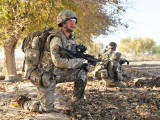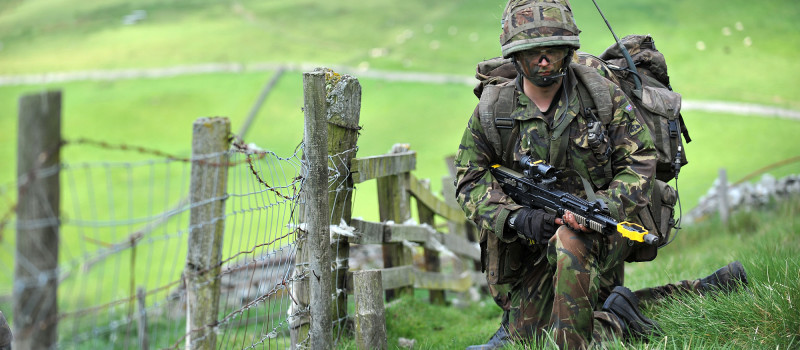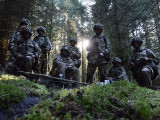

12th Armoured Infantry Brigade
12th Armoured Infantry Brigade (formerly known as 12th Mechanized Brigade) is one of the Army’s deployable brigades, based on Salisbury Plain as part of 3rd (UK) Division. Due to its complimentary make-up of armoured, medium and light-role troops, 12 Brigade is capable of a wide variety of missions anyway in the world.
The Brigade currently consists of a Headquarters Staff, four Combat units and a host of Combat Support and Combat Service Support units enabling it to live, move and fight wherever and whenever it is required.
On Op Herrick 16, March to October 2012, the Brigade was the lead formation of British troops in Helmand Province. On Op Herrick 6, in 2007, 12 Brigade was the first non-specialist Brigade to operate in Helmand Province in Southern Afghanistan. In 2005, the Brigade deployed to Iraq on Op Telic 6 returning in November of that year.
The brigade is based throughout the South of England, with its headquarters located in Ward Barracks, in Bulford Camp, Wiltshire.
History
12 Infantry Brigade was first mobilised for the Boer War in South Africa in 1899, commanded by Major General Clements. Prior to this date the Brigade existed on paper only. It was custom at this time for brigades to be known by the name of their commander rather than a number and Clements Brigade, as it was known, consisted of the 2nd Battalion the Bedfordshire Regiment, the 1st Battalion the Royal Irish Regiment, 2nd Battalion the Worcestershire Regiment and the 2nd Battalion, the Wiltshire Regiment. The Brigade went on to win battle honours at Rensburg, Norval’s Point, Biddulph’s Berg and Slabbert’s Nek. Following the end of the war in South Africa, 12 Brigade was sent back to England, with the Brigade headquarters located in Plymouth.
On the outbreak of the 1st World War the Brigade consisted of the 1st Battalion the Lancashire Fusiliers, the 2nd Battalion the Inniskilling Fusiliers and the 2nd Battalion the Essex Regiment. The Brigade soon saw action in the Battle of the Marne when the British Expeditionary Force pushed back the advancing Germans. However, the lines of trenches grew stronger over the following months and a stalemate developed and the hell of trench warfare became 12 Brigade’s existence. By the end of the war, the Brigade had won many battle honours and, after the signing of the Armistice, 12 Infantry Brigade was disbanded in January 1919.
In the Second World War, 12 Infantry Brigade embarked for France on 5th October to bolster the French Army against an expected German attack. At this time the Brigade consisted of the 2nd Battalion the Royal Fusiliers, the 1st Battalion the Royal Lancashire Regiment and the 6th Battalion the Black Watch. After fighting a desperate rearguard action, the Brigade withdrew along with the rest of the British Expeditionary Force and was evacuated from the French beaches on 30th May 1940. In February 1943, the Brigade was moved to North Africa.
The Brigade fought at Oved Zara, Medjez Plain and Tunis, quickly defeating the German Forces. With North Africa taken care of, 12 Brigade turned its attention to Italy disembarking at Naples in February 1944 to join the attacking forces around the town of Cassino. The subsequent fall of Cassino allowed the Allied forces to advance North driving the Germans out of Italy. The Brigade moved North, eventually heading for a ‘rest and training’ period in Greece. After the end of the war, the Brigade was disbanded in March 1947.
After reforming in April 1956 as 12th Infantry Brigade, the Brigade spent time in the UK and Germany changing roles several times as an Infantry Brigade Group, a Mechanized Brigade, the Osnabruck Garrison and Task Force Delta, and finally as an Armoured Brigade in January 1981 until its disbandment in 1992, after Options for Change.
The Strategic Defence Review in 1998 saw the reformation of the brigade as 12th Mechanized Brigade. In September 1999, Headquarters 12th Mechanized Brigade formed in Montgomery Lines, Aldershot and deployed to Bosnia for a six-month tour. On its return from Bosnia, the Brigade completed its formation in August 2000. It deployed on Op AGRICOLA in late 2002 and returned in 2003 to become the first brigade to bring the new BOWMAN communications system into service.
In 2005, the Brigade deployed to Iraq on Op TELIC 6 and then in the spring of 2007 deployed to Afghanistan on Op HERRICK 6. In the spring of 2012 the Brigade returned for its final tour of Afghanistan on Op HERRICK 16. Having completed their part in Op HERRICK the Brigade has concentrated on armoured training, and in 2014 will exercise within the UK as well as overseas in Kenya, Canada, Poland and France. In 2015, the 1st Battalion, The Yorkshire Regiment will join the Brigade to bring it to full operating strength.


